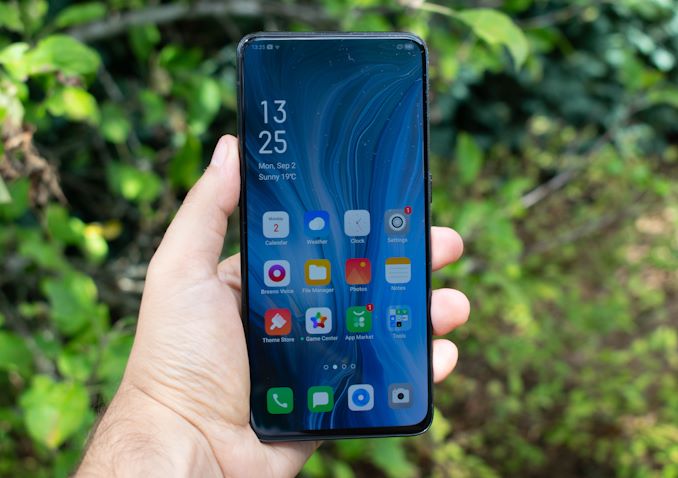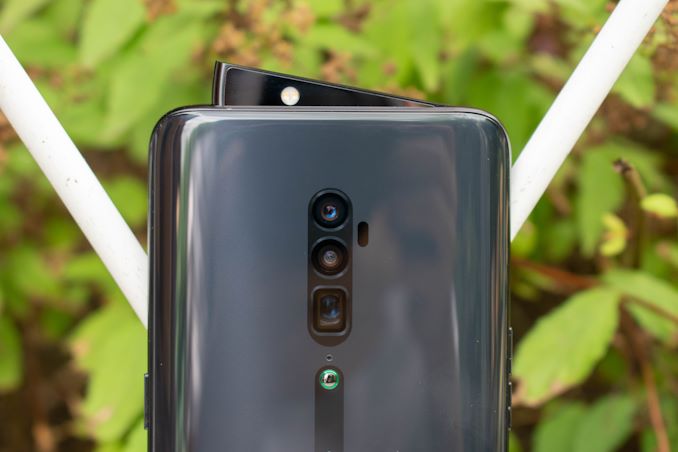The OPPO Reno 10x Zoom Review: Bezeless Zoom
by Andrei Frumusanu on September 18, 2019 10:00 AM EST- Posted in
- Mobile
- Smartphones
- Oppo
- Snapdragon 855
- Oppo Reno 10x Zoom
Conclusion & End Remarks
The Reno 10x Zoom the is the first Oppo device we’ve reviewed here at AnandTech, and frankly I wasn’t too sure what to expect going into this review.
The one aspect where the Reno 10x does stand out in is its design. The full screen display without any notches, bezels or cut-outs does make it one of the unique devices in 2019, but much like the many other implementations of this design this year, it comes with compromises in terms of the build of the phone. I don’t have any concerns on the build quality of the design, but it’s just an overall thicker and heavier phone, all of that just for the sake of eliminating a few millimetres of display notch for the camera. For some people who put more value into aesthetics, this might work, but I personally put more value into the practicality of a phone as well as its ergonomics. In the end, it’s the same compromises we found on the OnePlus 7 Pro and its retractable camera module.
The display of the phone is good, but nothing really that makes the Reno 10x stand out compared to the competition. It’s a large display, but at 1080p, it’s a bit stretched out in terms of resolution. Colour accuracy and calibrations were adequate, but falling in below average. There’s nothing particularly bad or good about it.
Performance of the phone was good, but at the very lower end of what you’d expect of Snapdragon 855 devices. On the CPU side of things, Oppo has configured the phone to be quite conservative in terms of its scheduler and DVFS scaling. It’s by far not a slow device, but below other S855 phones. On the GPU side of things, the phone behaves exactly like the OnePlus 7 Pro in that it doesn’t showcase any thermal throttling at all. However, unlike the OP7Pro, the Reno 10x heats up unevenly enough that the phone’s software thermal panics and closes the running app.
The one benefit of the more conservative CPU tuning of the device is in its battery life. Again, the Reno 10x doesn’t have the most recent or most efficient display, but thanks to the larger battery and its decision to be a bit slower in terms of ramping up the CPU, it performs very well in our battery tests, especially in PCMark. It’s also doing well in the web test, however because of the less efficient screen it just shy of the best devices out there.
On the camera side of things, the one thing I was more impressed with the Reno 10x in this review was the new Night Mode. I’ve had the phone for a few months now, but it really breathes some fresh life into the camera in low-light conditions. In terms of detail it’s now amongst the limited group of vendors who have working computational photography algorithms, even if it still needs more tuning.
In daylight pictures, the phone is versatile. The main camera in daylight is good, albeit the processing does lag behind the best results that the camera sensor is able to achieve; Xiaomi still seems to be the one vendor that had the best calibration for the IMX586. The ultra-wide angle was good and consistent with the mains sensor, although it didn’t have any obvious weaknesses it’s also lacking any kind of clear strengths.
The periscope design 5x optical zoom of the phone seems to be a gimmick to me. We already saw the feature on the P30 Pro, and like on that phone, in most situations it’s not quite as useful as some lower magnification lenses. The problem for the Reno 10x Zoom is the fact that it loses out in quality compared to the P30 Pro – sometimes quite significantly, producing blurrier pictures than its sole competitor.
In Europe, the Reno 10x Zoom can be found between 579 to 649€ depending on storage configuration. The issue I had with the Reno 10x is that I don’t feel like it had any one defining feature that put it ahead of the competition. Everything was relatively passable or adequate, not shining in any one area. For being a jack-of-all-trades, master-of-none phone, I feel it doesn’t convince me enough to actively recommend the phone over a competing solution. The phone has a cheaper sibling in the regular Reno, and the Reno 2 will also be released soon, but again I don’t feel like those phones substantially change the formula to make them worthwhile phones. Let’s hope Oppo continues to iterate in future designs, and better optimise and improve upon the core aspects of its phones.












40 Comments
View All Comments
Andrei Frumusanu - Wednesday, September 18, 2019 - link
Forgot to edit that subtitle.DanNeely - Wednesday, September 18, 2019 - link
Page1: "The display is an AMOLED panel featuring a 2340 x 1080 resolution and comes at a rather large diameter of 6.6”. " diameter should be diagonal.DanNeely - Wednesday, September 18, 2019 - link
"Oppo alleviates this concern by including a small raised nub below the cameras, causing the phone to never actually be flush against any surfaces and thus vastly reducing possible scratches of the back glass near the cameras."Does this mean that if you set it down on the table and try to use it you're going to have a wobbly bad time?
Andrei Frumusanu - Wednesday, September 18, 2019 - link
It wobbles if you press the top of the screen, the bottom 2/3rds are stable.trivik12 - Wednesday, September 18, 2019 - link
Since almost all flagship phones have night mode, can we do a shoot out and provide us strength and weakness plus overall winner. I guess best time would be when Pixel 4 is released.flyingpants265 - Wednesday, September 18, 2019 - link
-Needs front stereo speakers which allows you to hear youtube videos, movies, emulator games, camera videos, etc in full volume.-And wireless charging which is extremely useful, no port wear, start charging faster/with one hand, magnetic charging mount in the car.. Still use it all the time on my Nexus 5. Wireless charging pad cost me $3.00 on ebay.
-The missing 3.5 headphone jack is not really ideal..
melgross - Wednesday, September 18, 2019 - link
I’m not convinced that a pop up camera is a good idea, particularly if all that mechanics and electronic is there to just eliminate a hole in the screen.Notice that there’s no water and dust rating. That’s because it’s almost impossible to keep water and dust out of the slot. I can see grit from wind picking it up, being deposited inside that slot, eventually scratching the lenses and eventually causing the module to grind to a halt. Moisture too. It will remain in the slot for some time, causing problems.
eastcoast_pete - Wednesday, September 18, 2019 - link
Thanks Andrei! Agree with you and others here that the pop up camera is a gimmick that adds complexity and weight, not to mention anything that moves is another thing that can break. Too bad Oppo didn't put the extra weight and complexity to make a really good periscope style optical zoom camera - if done correctly, they can be spectacular.@Andrei: Lastly, one question and request: what about the call quality of this and other phones? Please add a sentence or two on this to your reviews, good call quality is a non-negotiable for me and probably many others.
I do use my smartphone as my main phone, and had to bench/retire my Xiaomi Mi Max 3 phone due to really horrible call quality (on both sides, got many complaints over poor voice quality). I loved many aspects of that phone, especially the big screen and battery, but it was basically useless as a daily driver. Now back to an older LG phone, not as good otherwise, but I can make and receive clear phonecalls.
PreacherEddie - Wednesday, September 18, 2019 - link
I believe the top of page 2 comes from a previous review and you need to edit it for the Oppo.edsib1 - Wednesday, September 18, 2019 - link
I have no idea how your Oppo10x zooms scores so low in benchmarks. My UK version scores very high in all benchmark scores. Antutu score of 370k, geekbench 4score 3514/11314 . Pcmark work2 performance score is 10564